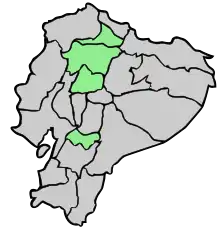Senecio iscoensis
Senecio iscoensis or Aetheolaena senecioides[3] is a flowering plant in the aster family. It is found only in subtropical and tropical dry shrubland in Ecuador. It is threatened by habitat loss.
| Senecio iscoensis | |
|---|---|
| Scientific classification | |
| Kingdom: | Plantae |
| Clade: | Tracheophytes |
| Clade: | Angiosperms |
| Clade: | Eudicots |
| Clade: | Asterids |
| Order: | Asterales |
| Family: | Asteraceae |
| Genus: | Senecio |
| Species: | S. iscoensis |
| Binomial name | |
| Senecio iscoensis | |
 | |
| Range of collection material | |
| Synonyms | |
|
Senecio decolor Benoist.[2] | |
It is known from three collections in the central and northern Andes. First recorded by Luis Sodiro, probably at the Hacienda Isco, it is also recorded from the foothills of Volcán Antisana and probably inside the reserve of the Antisana Ecological Reserve,[1] a privately owned reserve that preserves the native flora and fauna of the Northern Andean páramo.[4]
References
- Montúfar, R. & Pitman, N. (2003). "Senecio iscoensis". IUCN Red List of Threatened Species. 2003: e.T43843A10832885. doi:10.2305/IUCN.UK.2003.RLTS.T43843A10832885.en. Retrieved 2020-01-10.
- Tropicos. "Senecio iscoensis Benoist". Missouri Botanical Garden. Retrieved 2008-04-03.
- "Aetheolaena senecioides (Kunth) B.Nord". The Plant List Org. 2010.
- "Antisana Ecological Reserve". Summer Experience in Ecuador. Washington College and the University of San Francisco at Quito. 1998. Archived from the original on 2008-05-09. Retrieved 2008-04-02.
Further reading
- Engelmann, W. (1901). Botanische Jahrbücher für Systematik, Pflanzengeschichte und Pflanzengeographie (29 ed.). Stuttgart [etc.] Schweizerbart [etc.] QK1.B55.
This article is issued from Wikipedia. The text is licensed under Creative Commons - Attribution - Sharealike. Additional terms may apply for the media files.
